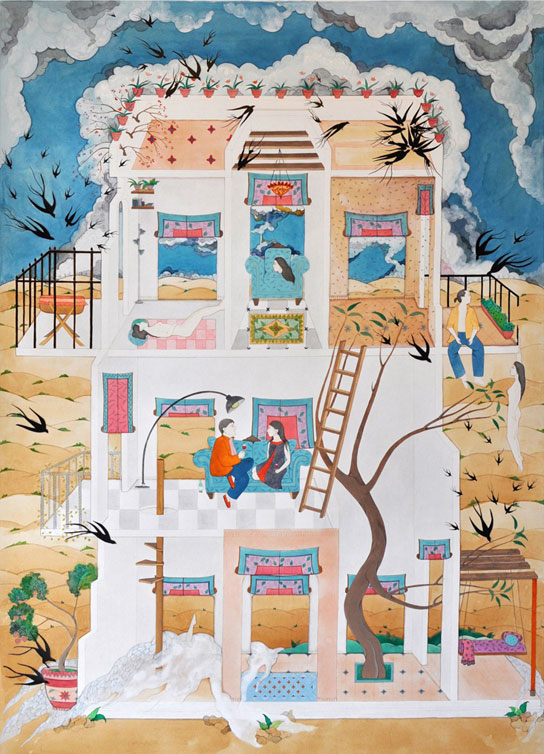Why did you choose the medium of miniature painting to execute these self-portraits? And in what way are these self-portraits?
Ever since I trained at the National College of Arts in Lahore, Pakistan, miniature painting has been my chosen medium of expression. I have found that the language and discipline native to this technique suit my work ethic and personality.
The recurring female figure in my work is a likeness of myself. Although my work is deeply personal, I use my own portrait symbolically to depict socio-cultural narratives.
Architecture seems to play an important role in your personal mythology, as it does in Sadik Kwaish Alfraji's video that Asymptote presented in October 2012. Can you comment on the significance of the various settings for each of these three paintings?
Architecture has featured heavily in my work ever since I moved to Brooklyn in 2010. I often depict spaces that are reminiscent of my home in Pakistan, or places that I have visited which are inspiring or have a nostalgic attachment for me.
The Sleepover (pictured above) was inspired by the devastating flooding in Pakistan that occurred the year I moved to New York. The house featured in this work is meant to be somewhat dilapidated, despite its colorful interiors. Water washes into the ground floor of the house and someone is drowning in it. However, the residents continue with life, oblivious to their plight.
My Selves portrays a journey that takes place within a fantastical landscape inspired by New York City. I chose the Manhattan skyline as the backdrop for this painting as I see the sun set over it every day from my studio window in Bushwick. A parade of figures moves past this breathtakingly beautiful skyline, referencing myriad personal interactions with the city.
The Guard comes from a visit to the Hagia Sophia, a building in which I saw a harmonious religious history beautifully preserved. Remnants of the church and Christian art endured alongside Muslim aesthetics. At the altar, a beautiful, iconic Madonna and child were flanked by two giant plaques inscribed with "Allah" and "Mohammad." What touched me was how these two religions had once co-existed, creating something magical, hopeful, and beautiful.
There are many recurring motifs in these self-portraits: birds, trees, naked bodies. What do they represent, insofar as you are able to say?
Scenes from nature are typical of traditional miniature painting. I have always been compelled by the beauty and perfection of nature, which comes forth in my paintings through the use of trees, clouds, and other elements of landscape painting. The birds in my work are neutral observers, representing a certain freedom and adding compositional movement. I often use the flow of the landscape and the creatures within them to allow the eye to travel through the work.
I usually depict the human body in its natural form. For me, the presence of nude figures suspends the painting in a timeless space, removing signifiers of a specific era, while alluding to a world of hidden perfection.
I love the mise-en-scène in these paintings—a lot of which has to do with your wonderful use of space, the way you weave different tableaux into one larger dream-like narrative. Can you tell us how you came into this spatial language?
My work borrows heavily from classical miniature paintings in homage to the medium's traditional roots. One example of this is the layering of perspective, which provides multiple views of the same space. This is most evident in My Selves, where the various buildings that form the skyline are painted from incongruent angles. The use of layered perspectives allows me to depict a metaphysical representation of earthly spaces. My aim is to create a world—a spiritual place—that transcends experience.

